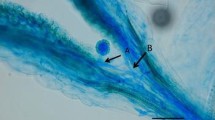Abstract
We have tried an insect-pollination self-incompatibility (SI) test to strictly evaluate the level of SI as a model for the actual F1 seed production field using radish as experimental material. Twelve inbred lines, homozygous for the S-alleles, were used in the artificial self-pollination and the insect-pollination SI test. There was a positive correlation (r = 0.606) between the results by these two methods. Some lines showed a low level of SI in the insect-pollination test despite showing a high level of SI in the artificial self-pollination test. On the other hand, no lines showing a low level of SI in artificial self-pollination had a high level of SI in insect-pollination. These results show that the insect-pollination SI test can be considered to be a more reliable and stricter method than the artificial self-pollination test with respect to an evaluation of SI levels. We have raised and analyzed an F2 population and F3 lines derived from an F1 cross between a line showing a high level of SI (R00-04) and one showing a low level. The rate of self-seed settings of the F2 population showed a binomial distribution. There were 39 high-level SI plants to 15 low-level SI plants. This result and F3 progeny tests suggested that the high level of SI which R00-04 showed is controlled by a dominant gene.




Similar content being viewed by others
References
Allard RW (1956) Formulas and tables to facilitate the calculation of recombination value in heredity. Hilgardia 24:235–279
Bateman AJ (1952) Self-incompatibility systems in angiosperms. (I.) Theory. Heredity 6:285–310
Bateman AJ (1955) Self-incompatibility systems in angiosperms. (III). Cruciferae. Heredity 9:52–68
Göring DR, Glavin TL, Schäfer U, Rothstein SJ (1993) An S receptor kinase gene in self-compatible Brassica napus has a 1-bp deletion. Plant Cell 5:531–539
Ikeda S, Nasrallah JB, Preiss RDS, Nasrallah ME (1997) An aquaporin-like gene required for the Brassica self-incompatibility response. Science 276:1564–1566
Good SV, Stephenson AG (2002) The inheritance of modifiers conferring self-fertility in the partially self-incompatible perennial, Campanula rapunculoides L. (CAMPANULACEAE). Evolution 56(2):263–272
Marshall DL, Ellstrand NC (1986) Sexual selection in Raphanus sativus: experimental data on nonrandom fertilization, maternal choice, and consequences of multiple paternity. The American Naturalist 127:446–461
Marshall DL, Ellstrand NC (1988) Effective mate choice in wild radish: evidence for selective seed abortion and its mechanism. The American Naturalist 127:446–461
Namai H, Ohsawa R (1986) Variation of reproductive success rates of ovule and pollen deposited upon stigmas according to the different number of pollen on a stigma in angiosperm. In: Mulcahy DL, Mulcahy GB, Ottaviano E (eds) Biotechnology and Ecology of Pollen, Springer-Verlag, New York, pp 63–68
Niikura S, Matsuura S (1997) Genomic sequence and expression of S-locus gene in radish (Raphanus sativus L.). Sex Plant Reprod 10:250–252
Niikura S, Matsuura S (1998) Identification of self-incompatibility alleles (S) by PCR-RFLP in radish (Raphanus sativus L.). Euphytica 102:379–384
Niikura S, Matsuura S (1999) Genetic variation of the S-alleles and level of self-incompatibility in the Japanese cultivated radish (Raphanus sativus L.) (in Japanese). Breed Res 1:211–220
Niikura S, Matsuura S (2000) Genetic analysis of the reaction level of self-incompatibility to a 4% CO2 gas treatment in the radish (Raphanus sativus L.). Theor Appl Genet 101:1189–1193
Niikura S, Matsuura S (2001) Genetic variation of the self-incompatibility alleles (S-alleles) in the cultivated radish (Raphanus sativus L.) by the PCR-RFLP method. Acta Hortic 546:359–365
Niikura S (2002) Practical studies of the self-incompatibility on vegetable seed breeding and production in the cruciferous vegetables. Proceedings of International Workshop Seed & Seedling Science & Technology, Taiwan. Food and Fertilizer Technology Center for the Asian and Pacific Region
Ruffio-Chable V, Herve Y, Dumas C, Gaude T (1997) Distribution of S-haplotypes and its relationship with self-incompatibility in Brassica oleracea. Part 1. In inbred lines of cauliflower (B. oleracea var 'botrytis'). Theor Appl Genet 94:338–346
Stout AB (1920) Further experimental studies on self incompatibility in hermaphroditic plants. J Genet 9:85–129
Tantikanjana T, Nasrallah ME, Stein JC, Chen CH, Nasrallah JB (1993) An alternative transcript of the S locus glycoprotein gene in a class II pollen-recessive self-incompatibility haplotype of Brassica oleracea encodes a membrane-anchored protein. Plant Cell 5:657–666
Watanabe M, Hatakeyama K, Takada Y, Hinata K (2001) Molecular aspects of self-incompatibility in Brassica species. Plant Cell Physiol 42:560–565
Yoshida K, Naito T, Takeda G (1994) cDNA cloning of regeneration-specific genes in rice by differencial screening of randomly amplified cDNAs using RAPD primers. Plant Cell Physiol 35:1003–1009
Zuberi MI, Lewis D (1988) Gametophytic-sporophytic incompatibility in the Cruciferae-Brassica campestris. Heredity 61:367–377
Acknowledgements
We thank Dr. Y. Fujita, an executive director of Tohoku Seed Company, for his support and Dr. S. Matsuura of Tohoku Seed Company for his generous advise during this study.
Author information
Authors and Affiliations
Corresponding author
Additional information
Communicated by H.F. Linskens
Rights and permissions
About this article
Cite this article
Horisaki, A., Tanaka, N. & Niikura, S. The effectiveness of insect-pollination test to evaluate the level of self-incompatibility and their genetic analysis in radish (Raphanus sativus L.). Theor Appl Genet 107, 1009–1013 (2003). https://doi.org/10.1007/s00122-003-1256-6
Received:
Accepted:
Published:
Issue Date:
DOI: https://doi.org/10.1007/s00122-003-1256-6




